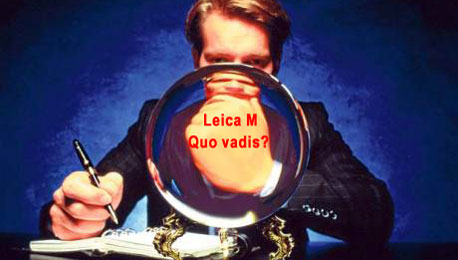Remember, you read it here first, a week before it was on all the other sites: the ominous X Vario’s name confirmed. But this post is not about unabashed self-promotion. Many photographers obviously want a “Mini M” that Leica marketing suggested. Leica could sell tons of slimmed down M with interchangeable lenses, EVF, image stabilization, sensor cleaning mechanism, some kind of autofocus, etc. — and it mustn’t even be full-frame. I’d be content enough with a 1.2 or even 1.3 crop factor. It’s not a question if Leica is working on such a camera. The question is when they’re ready with it. The main problem: legacy lenses.
One has to be allowed to raise a legitimate and fundamental question: why stick with old lenses when Leica could release a whole slew of new digital optimized lenses with a new mount. This “new M” would still allow old lenses to be mounted and do in-camera vignetting correction. For the new mount and new lenses, even legacy users would be all over this camera, because the X would still be all about optical quality, user control, design minimalism and reliability.

I assume with the move to the new factory in Wetzlar Leica will have the capacities and resources to design and tool up for a new line of lenses. They can’t sell Ms forever. They can do the sensor, they can do the electronics and the can do the lenses. Extra complications such as image stabilization need extra processing or mechanical shifting. Can be done.
Main problem is the legacy lenses’ acute angle of light incidence. Due to the fact that the rear element of rangefinder lenses is very close to the film or sensor plane, the light strikes the film (or sensor) at a very sharp angle. The registration distance of the Leica M mount is 27.8mm, of the EOS mount 44mm.
In SLRs the rear element of the lens is much further away due to the need to allow for clearance of the mirror, dictating a different optical design. Therefore, the light coming from SLR lenses strikes the sensor at easier to handle nearly 90 decrees. Film is more forgiving, but the M lenses’ very acute angle of the light striking the sensor leads to severe vignetting even in a smaller than 35mm sensor.
Leica could use a variety of new technologies to try and compensate for this. The new lenses would be completely different beasts. The Leica mystique could live on. People could still say they have the best class and therefore can produce the best pictures, even with a slightly smaller than 35mm sensor.
A reinvented M could help Leica to stay relevant. With Fujifilm, Carl Zeiss and Sony encroaching on Leica’s home turf, it won’t be enough to take care of Leica’s existing pool of lenses and users. The X Vario will fascinate point-and-shooters who are lusting for a real red made in Germany dot, even though the camera is developed and designed by a subsidiary of Panasonic.
But a new generation of photographers is coming. For Leica it won’t be enough to combine present and past. With the “Leica mojo” being copied and even enhanced by competitors, now is the time for an M that’s less built on heritage and more on looking ahead. That’s actually what Olympus and Panasonic did with first the Four Thirds and then the Micro Four Thirds system: designing a digital system from scratch.
Fact is, the digital M is not yet a truly digital M. It is determined by legacy glass. No way will Leica break the M and R legacy, but a large chunk of people would like an M with three or so lenses as a nice small system camera. But spending $15k? Not everyone’s budget. Key is to deescalate the price issue.
My feel is that the new improved Wetzlar factory and Leica plans for a next-generation digital M — and rest assured it will happen — go hand in hand. Give it a year or so. And then remember, you read it here first.


